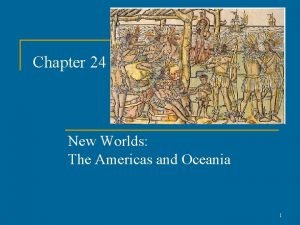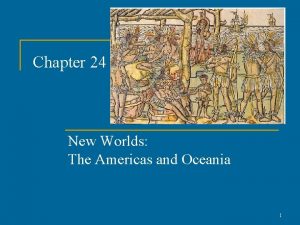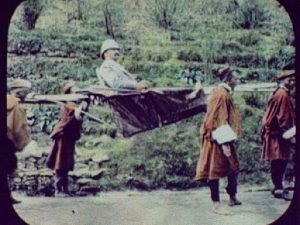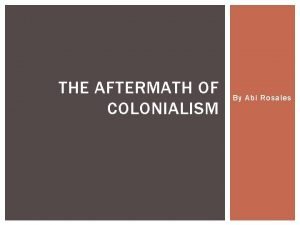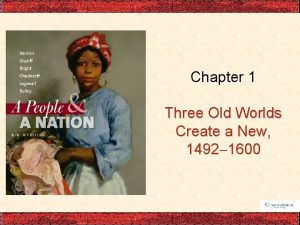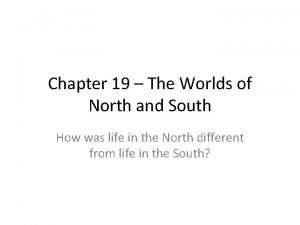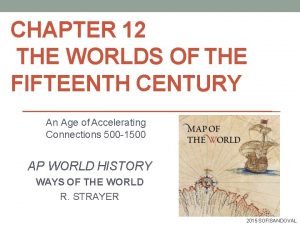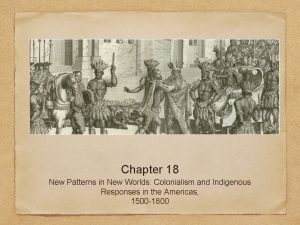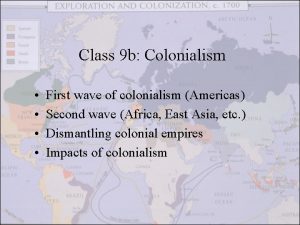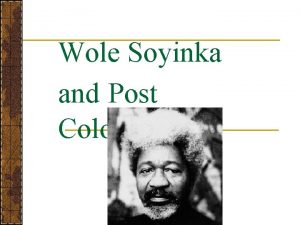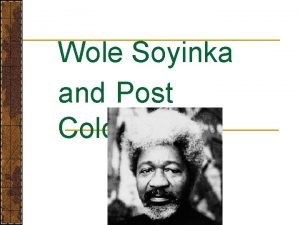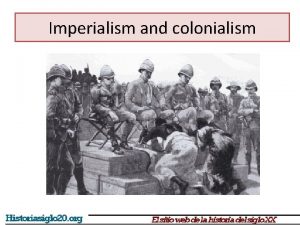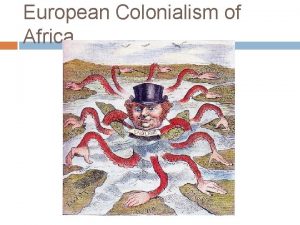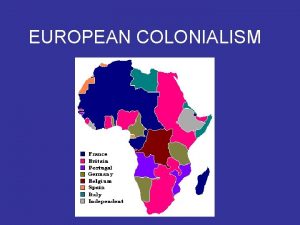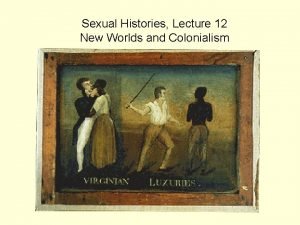Chapter 18 New Patterns in New Worlds Colonialism



























- Slides: 27

Chapter 18 New Patterns in New Worlds: Colonialism and Indigenous Responses in the Americas, 1500 -1800

The Americas in 1750

The Colonial Americas: Europe’s Warm Weather Extension • Trading posts turned into conquest in the Caribbean • Land-labor grants • Effect of smallpox on native population • Hernan Cortes sent to start trading posts in the Yucatan Peninsula

The Conquest of Mexico • Conquest of the Aztec Empire • Cortes allied with native peoples unhappy with Aztec rule • Captured Tenochtitlan with 2000 Spaniards and 50, 000 native soldiers • Encomienda: land-labor grants

European Exploration of the Americas, 1519 -1542

Conquest of the Inca Empire • Francisco Pizarro given permission to found a trading post in the Inca empire • The empire was ravaged by smallpox and in the midst of civil war • Pizarro looted Inca cities of wealth and used it to found Lima, on the coast Emperor Atahualpa

The Colonization of Central and South America to 1750

The Portuguese Conquest of Brazil • Resulted from Portuguese competition for trade with French • Explanations for the Spanish Success • Focused on removing the heads of societies, paralyzing opposition; weakness in empires and effect of smallpox made this easier; superior military technology meant that few Spaniards could hold their own against armies of Aztecs and Incas

The Establishment of Colonial Institutions • New colonies were centralized from the beginning • Dominated by creoles, Spaniards born in the New World • Riches gained from the Aztecs and Incas drove exploration and conquest • Real money came from exploiting mines and farmland using labor of native people • Small areas resisted conquest, particularly in the highlands or rainforest

Mexico and Central America, and the Caribbean, 1496 -1750

Spanish and Portuguese South America, 1525 -1750

Bureaucratic Efficiency • Delivered majority of the revenue of colonies to Spain • Rotating labor assignments (repartimientos) kept usage of the declining native population efficient • The Rise of the Creoles • Gained power as rule from Spain became too expensive

Northwest European Interference • French, English, and Dutch governments began to challenge Spanish dominance of the Caribbean • Privateers harassed Spanish shipping • New Bourbon dynasty in Spain attempted to regain control after 1700 • Naval connections and administrative control were improved • Lack of investment in Spanish industry made it easy for French and English to dominate exports to the Americas

Early Portuguese Colonialism • Expansion into the Interior • Driven by discovery of gold mines • Smallpox decimated the population, led to the importation of African slave labor • Brazil was a valuable colony by mid-18 th century Mine Workers

North American Settlements • Less hospitable than South America • Early English, French, and Dutch settlements struggled to survive • Religious zeal in the north and development of tobacco as a cash crop in the south aided colonial survival • Resistance from powerful native confederations • Impact of smallpox and wars between native-European alliances devastated the Native American population

The Colonization of North America to 1763

Patterns Up Close The Columbian Exchange is the exchange of resources between old world and new, benefiting both.

Territorial Expansion and the Seven Years’ War • Overpopulation in Europe led to expanding colonial populations • Settlers gained a voice in government through local assemblies • England took governance of colonies away from charter corporations in the late 17 th century, but the assemblies’ power survived • Restrictions on settlement made French colonies much smaller • Competition between British and French settlers in the Ohio River Valley led to the Seven Years’ War

The Making of American Societies • Ways in which colonies were integrated into European economy affected development of society • Spanish colonies focused on mining in Bolivia and Mexico • Exploitation of native labor made colonial mines a major source of Spanish wealth The Silver Mountain of Potosí

Exploitation of Mineral and Tropical Resources • Wheat Farming and cattle ranching developed in colonies to support the mining centers • Brazil began as a trading and farming colony, until the discovery of gold in the 18 th century • As plantation farming grew more important in North and South America, importation of slaves from Africa increased

Social Strata, Castes, and Ethnic Groups • Europeans were the social elite • Lower Creoles: craftsmen and merchants, not as wealthy as the elite but still of European descent • Mestizos and Mulattoes-mixed race population, higher than the natives on the social ladder • Position of women varied based on social position • Disease reduced the numbers of Amerindians in the first 150 years after conquest

New England Society Small family farm was the norm in early New England Large port cities emerged in the 18 th century Wealthy merchant class formed Placed priority on eduction-the majority of men were literate

The Adaptation of the Americas to European Culture • Catholic Missionary Work • Monarchs relied heavily on the Church to help them rule the colonies • Cults of saints and the Virgin Mary replaced traditional native gods Spanish cruelty to the Incas

Education and the Arts • Education was primarily through Catholic missionaries • Recording and Writing of native cultures and done by missionaries trying to understand the people they wanted to convert • Did not stop general mistreatment of natives

Protestantism in New England • Religious diversity defined English settlements in North America • Even in religiously unified colonies, like Massachusetts, dissenters frequently arose

New Sciences Research • New Science was more popular in English and Dutch colonies • Research by colonists like Ben Franklin added to the European tradition

Witch Hunts and Revivalism • Intense religious rivalry in the colonies led to the outbreak of witch hunts in the late 17 th century • Salem witch trials • Religious fervor also led to periods of revival • Great Awakening of the early 18 th century
 Slides
Slides Chapter 24 new worlds the americas and oceania
Chapter 24 new worlds the americas and oceania Chapter 24 new worlds the americas and oceania
Chapter 24 new worlds the americas and oceania Chapter 24 the americas and oceania
Chapter 24 the americas and oceania Imperialism vs colonialism
Imperialism vs colonialism Post colonialism in tempest
Post colonialism in tempest Star trek colonialism
Star trek colonialism Example of colonialism
Example of colonialism Impact of neo colonialism on third world countries
Impact of neo colonialism on third world countries Post colonial theory
Post colonial theory First wave of colonialism
First wave of colonialism First wave colonialism
First wave colonialism Colonialism vs imperialism venn diagram
Colonialism vs imperialism venn diagram Phases of colonialism
Phases of colonialism What were the causes of imperialism
What were the causes of imperialism Height of colonialism
Height of colonialism Negatives of colonialism
Negatives of colonialism Colonialism and development: korea, taiwan, and kwantung
Colonialism and development: korea, taiwan, and kwantung Electronic colonialism theory
Electronic colonialism theory Colonialism thesis statement
Colonialism thesis statement Three old worlds create a new
Three old worlds create a new In traditional dating patterns dating behavior
In traditional dating patterns dating behavior Closed patterns and max-patterns
Closed patterns and max-patterns Lesson 19 the worlds of north and south
Lesson 19 the worlds of north and south Chapter 20 the americas and oceania
Chapter 20 the americas and oceania Chapter 12 worlds of the 15th century
Chapter 12 worlds of the 15th century The worlds of the fifteenth century
The worlds of the fifteenth century Chapter 10 the worlds of christendom notes
Chapter 10 the worlds of christendom notes

